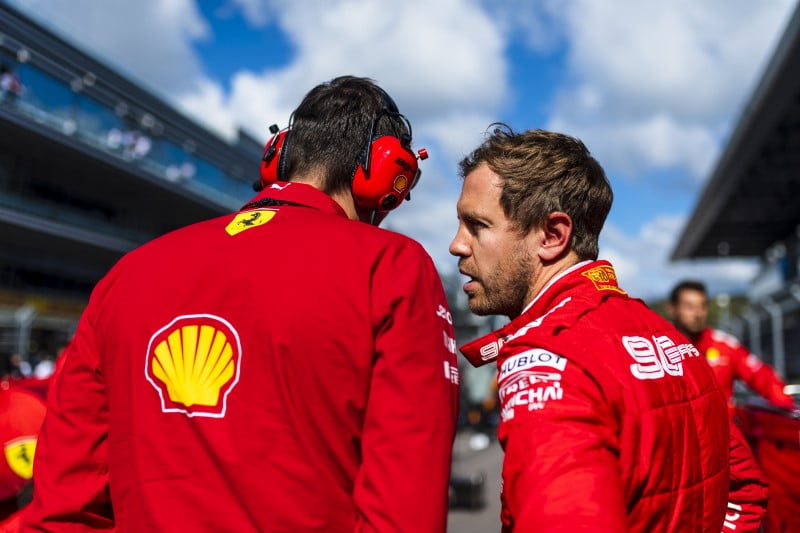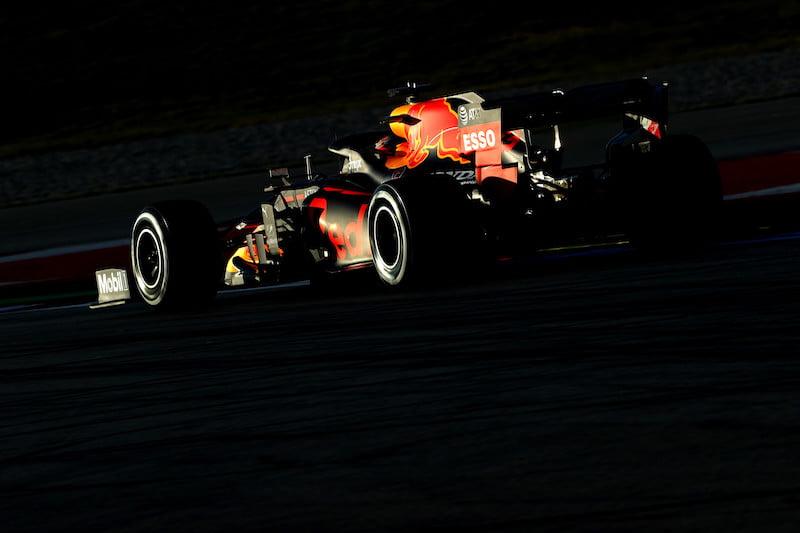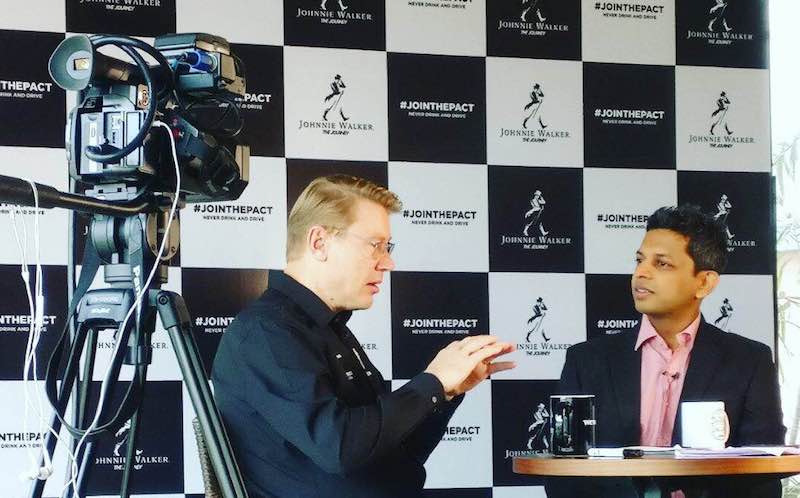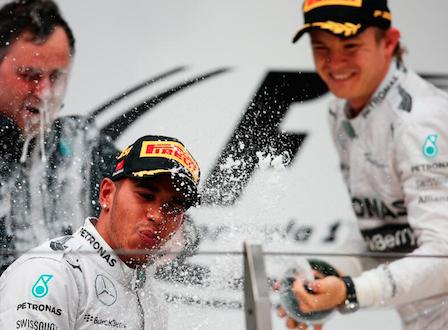Given their focus on pre-race agreements and radio exchanges, were Ferrari were overconfident of their chances in Russia?
- In the first half of the race, all of Formula 1 was tuned into the Ferrari radio channel as the team tried to please their drivers’ egos on a pre-race agreement that went out of the window from the start itself
- Lewis Hamilton clinched his ninth win of the season
- Mercedes’ win could be attributed more to luck than to pace or strategy, this is despite the reigning World Champions attempting a reverse strategy to Ferrari’s to try to jump them in the one-stopping race
There’s no way one could’ve scripted the 2019 Russian Grand Prix, even though Ferrari tried really hard to script the order in which their drivers finished. In the first half of the race, all of Formula 1 was tuned into the Ferrari radio channel as the team tried to please their drivers’ egos on a pre-race agreement that went out of the window from the start itself. And in the second half of the race, it was Charles Leclerc’s on-board camera angle that was the source of our entertainment. Could the Ferrari driver, who clinched his fourth successive pole position in qualifying, chase and overtake the Mercedes drivers for a victory?
Well, eventually, it was Lewis Hamilton who scored the win, his ninth of the season. Valtteri Bottas held off a charging Leclerc to score Mercedes’ eighth 1-2 of the season — their last being the 2019 British Grand Prix held in July. The Red Bull Racing drivers Max Verstappen and Alexander Albon charged through the grid (thanks to penalties) to claim fourth and fifth places, while Mclaren’s Carlos Sainz Jr. scored a fine sixth place for the team. Sergio Perez, Lando Norris, Kevin Magnussen and Nico Hulkenberg claimed positions seventh to 10th – as seven out of the ten teams scored points from the race.
A win against the odds for @MercedesAMGF1 and @LewisHamilton in Sochi
Here’s the story of how they got the better of Ferrari at the #RussianGP ??#F1 pic.twitter.com/YeJOsBiYwe
— Formula 1 (@F1) September 29, 2019
However, Mercedes’ win could be attributed more to luck than to pace or strategy — this is despite the reigning World Champions attempting a reverse strategy to Ferrari’s to try to jump them in the one-stopping race. Like Spa, Monza and Singapore, Ferrari did well to score pole position (courtesy Leclerc’s phenomenal one-lap pace) and ensure clean getaways before building comfortable gaps for their rivals. However, Ferrari’s race got entangled in a complex web of an understanding of a pre-race agreement between their drivers. As a result, Ferrari were busy on the radio pacifying one driver (Leclerc) while urging the other (Vettel) to give up the position. Luckily for them, Mercedes-Hamilton’s tyre strategy was yet to come into play, else the team’s focus would’ve been elsewhere. Ferrari’s pre-race agreement seemed a bit too excessive, in theory, and in execution. In fact, when quizzed post-race, both Ferrari drivers offered different versions of the agreement. But one needs to feel for Ferrari. At last year’s Italian Grand Prix, the team were called out for not managing their race properly. In Russia, they were called for doing exactly that!
Vettel-Leclerc’s pre-race agreement
Ferrari’s late-season form means that they are out of championship contention and are comfortable in second place. Given this situation, the team and its drivers are making decisions on a race-by-race basis without specific preferential treatment towards a particular driver. Their objective is simple — beat Mercedes and maximise as many points for the team as possible, and the team has acted ruthlessly on this objective as we saw in Singapore. For Russia, Leclerc’s pole position was much celebrated, but that also disadvantaged him at the start. The long straight to Turn 1 meant that Leclerc would be punching a hole in the air for his rivals, effectively offering them a slipstream to beat him in the braking zone. To make matters complex for Ferrari, Hamilton out-qualified Vettel to second place, thanks to a brilliant third sector in his final Q3 lap. To counter Hamilton at the start and to have both Ferraris ahead, Leclerc-Vettel entered into a pre-race agreement where Leclerc would give Vettel a slipstream to beat Hamilton, one that could also give Vettel the speed advantage to beat Leclerc into Turn 1.
Ferrari’s radio exchanges are fun, but this is silly strategy thinking & management of the #RussianGP. VET not yielding, LEC’s pissed off – Ferrari have barely found their feet this season & now to handle the driver mess. #F1
— Kunal Shah (@kunalashah) September 29, 2019
While this would work perfectly well for Ferrari, it would take away Leclerc’s lead of the race. Normally, the driver leading the field would take the inside line to defend position, however, Leclerc agreed that he would let Vettel take the inside line — basically, play to the team’s interests. Ferrari’s Team Principal Mattia Binotto explained the pre-race agreement, “Being first and second was the first objective. How can you do that when you start first and third? Certainly protecting the first position as well as making sure you gain a position and being second. We agreed together that the best way was not to give any slipstream to Hamilton first, because giving a slipstream to Hamilton would have given him some advantage or at least some possibility, and therefore Charles would have given the slipstream to Seb. That was what we agreed, and discussed — (that) by giving the slipstream to Seb and not defending the position would have given an advantage to Seb, which later on in the race we would give back (to Leclerc) by swapping the cars. So that was the deal.”
Why Vettel didn’t yield To Leclerc
To neutralise the impact on Leclerc’s race, it was also agreed that Vettel would then swap positions with his team-mate, thereby maintaining a 1-2 for the team, while giving Leclerc back his lead. All of this went to plan, apart from two incidents that defined Ferrari’s opening part of the race. First, Vettel had the best start of the top-3 drivers and didn’t need Leclerc’s slipstream to overtake Hamilton. The second incident was Vettel’s opening race pace. He was significantly faster than Leclerc and this allowed him to open up a gap over nearly 1.5 seconds — one that Ferrari admitted was large enough to not engineer a swap in the opening laps of the race. In fact, a third reason could be Leclerc’s failure to give Vettel the tow in qualifying in Monza. Was this Vettel’s payback? During intense chatter over the pit-to-car radio, memories of Vettel’s ‘multi 21’ incident during his days at Red Bull Racing were recalled. Back then too, Vettel ignored team orders. However, Ferrari restored normalcy during the pit-stops. They pitted Leclerc first, one that gave him the undercut advantage and retake the lead from Vettel. However, Binotto admitted post-race that Leclerc’s early stop wasn’t to undercut Vettel.
A lot of Ferrari pre-race agreements falling out of order. In Monza, it was in qualifying. In Russia, it is in the race.
For Ferrari, choice is difficult – who to favour? Their 4-times World Champion, or a the future World Champion? It isn’t car issues alone that trouble them
— Kunal Shah (@kunalashah) September 29, 2019
If so, it was strange for Ferrari to not pit Vettel on the next lap itself, after all, he was the faster of the two drivers in the race. Either way, for new followers of Formula 1, it must be stated that the structure of the sport allows to legally decide the order in which their drivers could finish – this is, of course, assuming that their drivers are running in succession in the race order. Binotto defended the team’s call to pit Vettel four laps later, “We knew as well that if we stopped both our cars there we would have been vulnerable on safety cars, by leaving the lead to Hamilton. We tried to stay out as much as we could with Seb, simply to protect in case of safety cars at that period of the race. Then again, Seb’s tyres were worn, he called for it, it was the right moment to pit, he pitted and as a matter of fact Charles was ahead, Seb was behind, but the race was still not over, and there would have been plenty of opportunities to decide then what would have been the best option later on.” Irrespective, Ferrari were running 1-2 in the race, Leclerc leading Vettel, while everyone waited to see how Mercedes’ medium tyre gamble would unfold.
Where Mercedes got lucky
However, in a twist of fate (and karma, if you believe Jacques Villeneuve), the MGU-K on Vettel’s Ferrari failed on the lap after his pit stop. The team instructed Vettel to stop on the track, an act that brought out the Virtual Safety Car (VSC). Mercedes-Hamilton were quick to act and pit under the VSC — basically, losing less time in the pits than Leclerc. As a result, Hamilton exited the pits ahead of Leclerc and in the lead of the race. After chasing Leclerc for three races in a row, it was the first time Hamilton led the Monegasque driver in a race even though it was through luck.
That Sochi P3 grid position…
???#RussianGP ?? #F1 pic.twitter.com/DXEvQpOh4F
— Formula 1 (@F1) September 30, 2019
Could Vettel have driven back to the pits since his ICU (internal combustion engine) was running fine and would that have avoided the VSC that cost Ferrari-Leclerc the win? Did Vettel purposely park his car on the track to trigger the VSC? As much as the conspiracy theorists would like us to believe that, the FIA and Ferrari acted in a manner they should. However, the FIA should undertake discussions if pitting under the VSC should be disallowed a la taking a leaf out of the Formula 2 rule book. There are pros and cons to this debate and out of the scope of the post-race column.
Ferrari’s error with Leclerc
George Russell’s Williams mysteriously ended up in the barriers, triggering an immediate Safety Car after the VSC period. Here, Ferrari reacted a lap too late in pitting Leclerc for the second time for the soft tyre. As a result, Leclerc lost the second place to Bottas, while having fresher rubber. Once the race resumed normalcy, Leclerc chased Bottas for nearly 20 laps. But despite the apparent straight-line speed advantage, the Mercedes package proved to be too fast for the Ferrari to usurp. Hamilton, who also clinched the fastest lap of the race, is now 73 points ahead of Bottas in the Drivers’ Championship. If not at the next race in Japan, there is a good chance that Hamilton could clinch his sixth World Championship at Mexico, a race he clinched his titles in 2017 & 2018 too.
From the pit lane to P5
An incredible drive by @alex_albon on Sunday in Sochi ?
And this superb pass on Pierre Gasly was one of the highlights ?#RussianGP ?? #F1 pic.twitter.com/HcQXNicFC2
— Formula 1 (@F1) September 29, 2019
Finally, all Honda-powered cars decided to take grid penalties in Russia, given that overtaking here is easier than in the next few races to come. While the Toro Rosso drivers failed to score points, Max Verstappen, who started 9th (after qualifying 4th + engine penalties), drove well to overtake the mid-field cars and finish 4th. Post-race, the Dutch driver admitted to his frustration to not be able to fight for wins and podiums as Red Bull Racing’s form has been found wanting in the second half of the season. Alexander Albon, the driver who is under watch for a seat alongside Verstappen in 2020, recovered extremely well in the race to finish fifth despite starting from the pit lane.
?⚫️?⚫️?
⚫️?⚫️?⚫️#RussianGP ?? #F1 pic.twitter.com/60QiAaVp6C— Formula 1 (@F1) September 30, 2019
Mclaren’s Resurgence
Mclaren started their Russian Grand Prix with an interesting announcement — becoming Mercedes’ customer team from 2021. After ditching Mercedes power units for Honda from 2015 and a further switch to Renault last year, Mclaren made a sensible decision to return to championship-winning power units to aid the team’s recovery in the sport. In 2019, the team has already scored more points than they did in 2017 and 2018 combined and have a solid driver line-up in Sainz and Norris. The team has failed to score in only four out of the 16 races held this season and in Russia, Sainz was challenging Hamilton for 3rd place at the start of the race. In the hybrid turbo era, no customer team has been a title contender through the course of the season, however, for Mclaren, being able to play with the top-3 consistently is the need of the hour and hopefully Mercedes power allows them to do so.
Okay, I can confirm this – the BEST FINISH EVER for an Indian in any Formula 1 feeder series. Whatta talent! Never ending support from his family & team, and brilliant execution by the driver himself. #India #Sport #RoadToF1 #F1 #F3 https://t.co/mkfulMTMNh
— Kunal Shah (@kunalashah) September 29, 2019
Jehan Daruvala – India’s brightest racing Talent
Indian racer Jehan Daruvala ended his Formula 3 championship campaign in a fine 3rd place — registering the best result ever for any Indian in a Formula 1 feeder series. This year’s Formula 3 grid was one of the toughest in recent times with nine drivers scoring wins through the season meaning that a top-5 finish in itself would be an uphill task. Jehan scored two wins and five podiums en route to 3rd place and will most definitely be making the jump to Formula 2 next year.
Up next is the 2019 Japanese Grand Prix at the legendary Suzuka circuit. Will Red Bull Racing’s package bring them into the Ferrari-Mercedes fight? Will Ferrari be able to manage their driver relationships that already seem to be deteriorating with every passing race this season? There’s lots to look forward to in a fortnight’s time.
This post was first published on Firstpost














